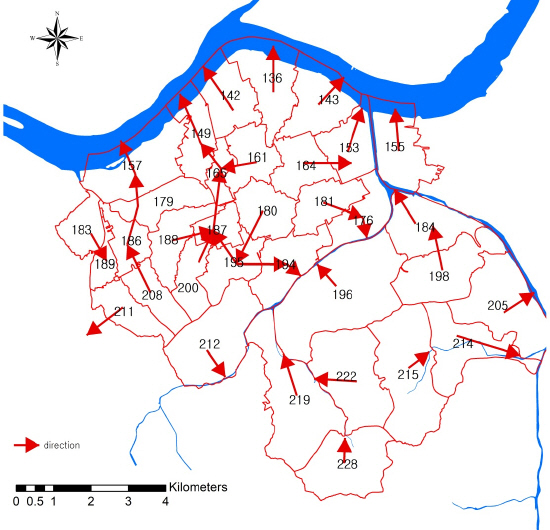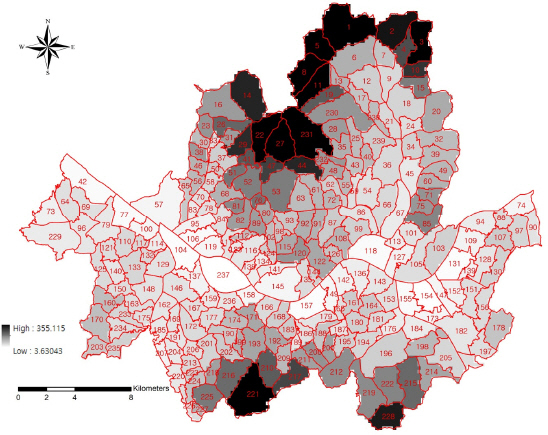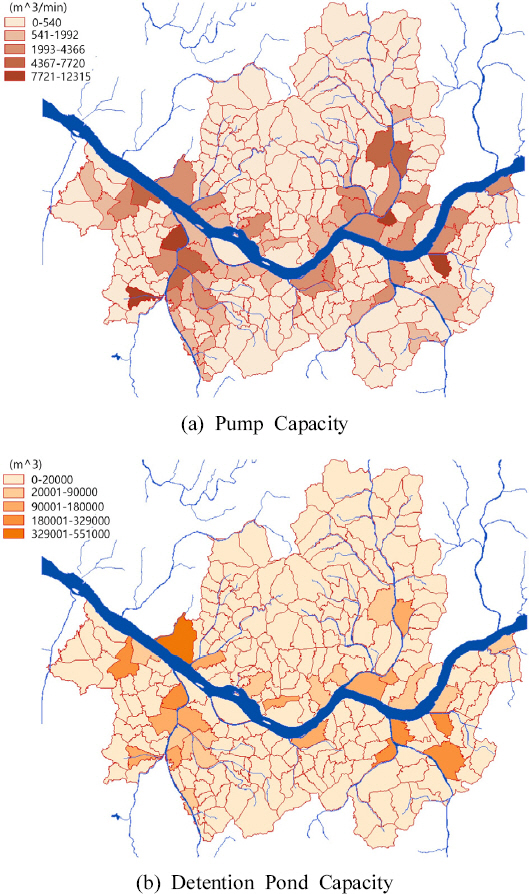1. Ahn, S.R, Jung, C.G, and Kim, S.J (2015) A study on the effectiveness of radar rainfall by comparing with flood inundation record map using KIMSTORM (Grid-based KIneMatic Wave STOrm Runoff Model).
Journal of Korea Water Resources Association, Vol. 48, No. 11, pp. 925-936.

2. An, H.U, Jeong, A.C, Kim, Y.S, and Noh, J.S (2018) Development of 2D inundation model based on adaptive cut cell mesh (K-Flood). Journal of Korea Water Resources Association, Vol. 51, No. 10, pp. 853-862.
3. Arabameri, A, Saha, S, Chen, W, Roy, J, Pradhan, B, and Bui, D.T (2020) Flash flood susceptibility modeling using functional tree and hybrid ensemble techniques. Journal of Hydrology, Vol. 587, pp. 1-15.
4. Bruwier, M, Archambeau, P, Erpicum, S, Pirotton, M, and Dewals, B (2017) Shallow-water models with anisotropic porosity and merging for flood modeling on Cartesian grids.
Journal of Hydrology, Vol. 554, pp. 693-709.

5. Chang, F.J, Chen, P.A, Lu, Y.R, Huang, E, and Chang, K.Y (2014) Real-time multi-step-ahead water level forecasting by recurrent neural networks for urban flood control.
Journal of Hydrology, Vol. 517, pp. 836-846.

6. Chen, J, Hill, A.A, and Urbano, L.D (2009) A GIS-based model for urban flood inundation.
Journal of Hydrology, Vol. 373, pp. 184-192.

7. Cheng, Z.Y, Georgakakos, K.P, Spencer, C.R, and Banks, R (2022) Numerical modeling of flash flood risk mitigation and operational warning in urban areas.
Water, Vol. 14, pp. 2494.

8. Han, K.Y, Cho, W.H, Lee, K.T, and Lee, C.H (2007) Application and evaluation of numerical modeling for urban flood inundation analysis. 2007 Conference of Korea Water Resources Association, pp. 1337-1341.
9. Kang, H.S, Cho, J.W, Lee, H.S, Hwang, J.G, and Moon, H.J (2021) Development of an ANN-based urban flood alert criteria prediction model and the impact of training data augmentation.
Journal of Korean Soc. Hazard Mitigation, Vol. 21, No. 6, pp. 257-264.


10. Kim, B, Sanders, B.F, Famiglietti, J.S, and Guinot, V (2015) Urban flood modeling with porous shallow-water equations:A case study of model errors in the presence of anisotropic porosity.
Journal of Hydrology, Vol. 523, pp. 680-692.

11. Kim, K.D, Kim, T.E, Kim, D.S, and Yang, S.K (2019) An automated open GIS-based tool development for flood inundation mapping and its applications in Jeju Hancheon. Journal of the Korean Society of Civil Engineers, Vol. 39, No. 6, pp. 691-702.
12. Lee, B.J, and Yoon, S.S (2017) Development of grid based inundation analysis model (GIAM). Journal of Korea Water Resources Association, Vol. 50, No. 3, pp. 181-190.
13. Lee, C.H, Han, K.Y, and Noh, J.W (2006) Development of urban inundation analysis model using dual-drainage concept. Journal of the Korean Society of Civil Engineers, Vol. 26, No. 4B, pp. 379-387.
14. Lee, E.H, and Kim, J.H (2018) Development of a flood- damage-based flood forecasting technique.
Journal of Hydrology, Vol. 563, pp. 181-194.

15. Lee, E.S (2020) Development of a vulnerability diagnosis model for urban surface water floods using building big data.
Climate Change Research, Vol. 11, No. 1, pp. 65-75.

16. Lee, S.S, Noh, S.J, Jang, C.H, and Rhee, D.S (2017) Simulation and analysis of urban inundation using the integrated 1D-2D urban flood model. Journal of Korea Water Resources Association, Vol. 50, No. 4, pp. 263-275.
17. Lee, W, Kim, J.S, and Yoon, S (2015) Inundation analysis in urban area considering of head loss coefficients at surcharged manholes.
Journal of Korea Water Resources Association, Vol. 48, No. 2, pp. 127-136.

18. Li, G, Zhao, H.D, Liu, C.S, Wang, J.F, and Yang, F (2022) City flood disaster scenario simulation based on 1D-2D coupled rain-flood model.
Water, Vol. 14, pp. 3548.

19. Li, S, Wang, Z, Lai, C, and Lin, G (2020) Quantitative assessment of the relative impacts of climate change and human activity on flood susceptibility based on a cloud model.
Journal of Hydrology, Vol. 588, pp. 1-14.

20. Sun, D.K, Kang, T.U, and Lee, S.H (2021) Sensitivity analysis and coverage review of the parameters for inundation simulations of coastal areas using XP-SWMM.
Journal of Korean Soc Hazard Mitigation, Vol. 21, No. 5, pp. 59-68.


21. Xie, S, Wu, W, Mooser, S, Wang, Q.J, Nathan, R, and Huang, Y (2021) Artificial neural network based hybrid modeling approach for flood inundation modeling.
Journal of Hydrology, Vol. 592, pp. 1-14.

22. Yoon, S.B, Lee, J.H, Kim, G.H, and Son, J.H (2014) Development of storm sewer numerical model for simulation of coastal urban inundation due to storm surge and rainfall.
Journal of Korean Society of Coastal and Ocean Engineers, Vol. 26, No. 5, pp. 292-299.






















